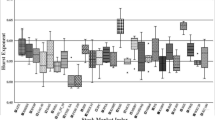Abstract
While there are various theories to account for the large variations in stock prices, some observed statistical aspects require further analysis. A model is proposed for aggregate stock prices, based on observed data, rather than any efficient market hypothesis, and considering jumps in statistical parameters between phases of generally increasing, or generally decreasing, aggregate stock prices. The model relates a critical parameter for short-term behaviour directly to financial factors, especially interest rates, to explain large short-term variations which follow a non-Gaussian distribution. Economic fundamentals may affect changes over longer periods.








Similar content being viewed by others
References
Andersen TG, Bollerslev T (1998) Answering the sceptics: yes, standard volatility models do provide accurate forecasts. Int Econ Rev 39(4):885–905
Baillie RTG, Bollerslev T, Mikkelsen HO (1996) Fractionally integrated generalized autoregressive heteroscedastity. J Econ 74(1):3–30
Bollerslev T (1986) Generalized autoregressive conditional heteroskedastity. J Econ 3(3):307–337
Bradford de Long J, Schleifer A, Summers LH, Waldmann RJ (1990) Positive feedback investment strategies and destabilizing rational speculation. J Finance 45(2):379–395
Cai J (1994) A Markov model of swithing-regime ARCH. J Bus Econ Stat 12(3):309–316
Christiansen C (2005) Level-ARCH short-rate models with regime switching: bivariate modeling of US and European short rates, Aarhus School of Business, Department of Accounting, Finance and Logistics, Working paper 05.3
Cuthbertson K (1996) Quantitative financial economics: stocks, bonds, and foreign exchange. Wiley, Chichester
Eguíluz VM, Zimmermann MG (2000) Transmission of information and herd behavior: an application to financial markets. Phys Rev Lett 25(26):5659–5662
Feller W (1966) An introduction to probability theory and its applications, Vol II. Wiley, New York
Fernandes M (2006) Financial crashes as endogenous jumps: estimation, testing and forecasting. J Econ Dyn Control 30:111–141
Fitzherbert R (2003) The identification and measurement of speculative risk. Institute of Actuaries, Australia (25 August, 2003)
Gabaix X, Gopikrishnan P, Plerou V, Stanley HE (2005) Institutional investors and stock market stability, NBER Working Paper No. 11722
Gopikrishnan P, Plerou V, Amaral LA Nunes, Meyer M, Stanley HE (1999) Scaling of the distribution of fluctuations of financial market indices. Phys Rev E 60(5):5305–5316
Hamilton JD (1994) Time Series Analysis. Princeton University Press, Princeton, NJ
Hurst H (1951) Long term storage capacity of reservoirs. Trans Am Soc Civil Eng 116:770–799
Islam SMN, Watanapalachaikul S (2005) Empirical finance modelling and analysis of emerging financial and stock markets. Physica-Verlag, Heidelberg
Kalimikpalli M, Susmel R (2001) Regime-switching stochastic volatility and short-term interest rates, CEMA Working Paper 192, http://www.cema.edu.ar/publicaciones/download/documentos/197.pdf
Kapopoulos P, Siokis G (2005) Stock market crashes and dynamics of aftershocks. Econ Lett 89(1):48–54
Kettell B (2001) Financial economics: making sense of information in financial markets. Prentice-Hall, London
Kindleberger CP (2000) Manias, panics and crashes: a history of financial crises, 4th edn. Wiley, New York
Mandelbrot BB (1963) New methods in statistical economics. J Polit. Econ. 71:421–440
Mandelbrot BB, Hudson RL (2004) The (mis)behaviour of markets. Profile Books, London
Mills TC (1999) The econometric modelling of financial time series, 2nd edn. Cambridge University Press, Cambridge, UK
Mills TC (2004) Exploring the relationship between gold and the dollar. Significance 1(3):113–115
Rahman S, Lee C-F, Ang KP (2002) Intraday return volatility prcoess: evidence from NASDAQ stocks. Rev Quant Finance Account 19:155–180
Ratti RA, Seo J (2003) Multiple equilibria and currency crisis: evidence for Korea. J Int Money Finance 22:681–696
Reed WJ, Hughes BD (2002) From gene families and genera to incomes and internet file sizes: Why power laws are so common in nature. Phys Rev E 66:067103
Sampson M (2003) New eras and stock market bubbles. Struct Change Econ Dyn 14:297–315
Voit J (2001, 2003) The statistical mechanics of financial markets. Springer, Berlin
Wang K-L, Fawson C, Barrett CB (2002) An assessment of empirical model performance when financial market transactions are observed at different data frequencies: an application of East Asian data rates. Rev Quant Finance Account 19:113–129
Xu Zhaoxaia, Gençay Ramazan (2003) Scaling, self-similarity ans multifractality in FGX markets. Physica A 323:578–590
Zeeman EC (1974) On the unstable behaviour of stock exchanges. Journal of Mathematical Economics 1:39–49
Acknowledgement
The authors thank a referee for some valuable criticism.
Author information
Authors and Affiliations
Corresponding author
Rights and permissions
About this article
Cite this article
Craven, B.D., Islam, S.M.N. A model for stock market returns: non-Gaussian fluctuations and financial factors. Rev Quant Finan Acc 30, 355–370 (2008). https://doi.org/10.1007/s11156-007-0066-3
Received:
Accepted:
Published:
Issue Date:
DOI: https://doi.org/10.1007/s11156-007-0066-3




